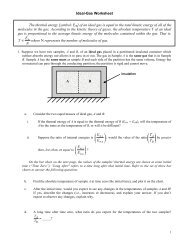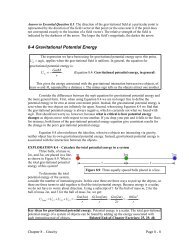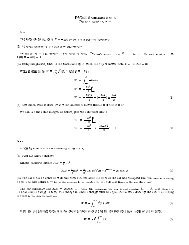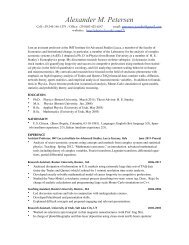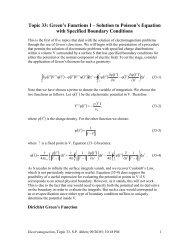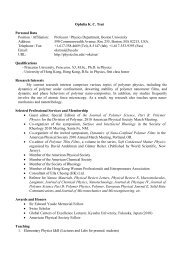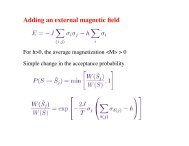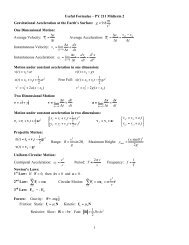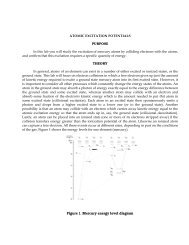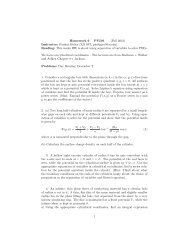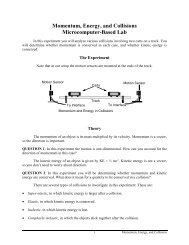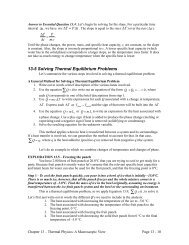Page 1 PY105S Unit 1 – Worksheet for Vectors and Vector Addition ...
Page 1 PY105S Unit 1 – Worksheet for Vectors and Vector Addition ...
Page 1 PY105S Unit 1 – Worksheet for Vectors and Vector Addition ...
- No tags were found...
You also want an ePaper? Increase the reach of your titles
YUMPU automatically turns print PDFs into web optimized ePapers that Google loves.
<strong>PY105S</strong> <strong>Unit</strong> 1 – <strong>Worksheet</strong> <strong>for</strong> <strong><strong>Vector</strong>s</strong> <strong>and</strong> <strong>Vector</strong> <strong>Addition</strong>Knowing how to work with vectors, add vectors, <strong>and</strong> distinguish between vectors<strong>and</strong> scalars will be an important part of the course.What is a vector? Give a brief definition in words.Give some examples of quantities that are vectors.What is a scalar? Give a brief definition in words.Give some examples of quantities that are scalars.Consider the following right-angled triangle. The hypotenuse has alength of 5 m, <strong>and</strong> the angle opposite side a is 30˚. What is the lengthof side a <strong>and</strong> side b?What is the relationship between a, b, <strong>and</strong> c in a general right-angled triangle?What is the relationship between a, b, <strong>and</strong> c in a triangle that has an angle! opposite side c? Show that the Pythagorean Theorem is a special case ofcthis relationship <strong>for</strong> !c= 90° .You have two vectors of length ______ <strong>and</strong> ______ . You get to choose the direction ofeach vector. When you add these two vectors tip-to-tail what is……the largest resultant vector you can obtain?…the smallest resultant vector you can obtain?Can you obtain resultant vectors of all possible lengths between the smallest <strong>and</strong> largestvalues?CHALLENGE: Prove your last statement mathematically.<strong>Page</strong> 1
The grid lines in the figure are 1 m apart. Four“displacement” vectors A, B, C <strong>and</strong> D have beendrawn on the diagram. Which two displacementvectors are equal? Why?Add vectors A <strong>and</strong> B together tip-to-tail. Draw theresultant vector. How long is the resultant vector?ADIn which direction is the resultant vector?BCDoes it matter in which order you add the vectors? Is A v + B v the same as B v + A v , or not?Consider the resultant vector obtained by adding the vectors A <strong>and</strong> D.What is the x-component of this resultant vector?What is the y-component of this resultant vector?What is the magnitude of this resultant vector?CHALLENGE: What is the direction of this resultant vector? (Feel free to write down anexpression <strong>for</strong> the sine, cosine, or tangent of an appropriate angle if you can’t determinean angle directly.)CHALLENGE SECTIONYou have three vectors of length 4m, 7 m, <strong>and</strong> 9 m. You get to choose the direction ofeach vector. When you add these three vectors what is……the largest resultant vector you can obtain?…the smallest resultant vector you can obtain?You have three vectors of length 4m, 7 m, <strong>and</strong> 16 m. You get to choose the direction ofeach vector. When you add these three vectors what is……the largest resultant vector you can obtain?…the smallest resultant vector you can obtain?Other topics to pay attention to: Changing units, dimensional analysis.<strong>Page</strong> 2



![arXiv:1303.7274v2 [physics.soc-ph] 27 Aug 2013 - Boston University ...](https://img.yumpu.com/51679664/1/190x245/arxiv13037274v2-physicssoc-ph-27-aug-2013-boston-university-.jpg?quality=85)
